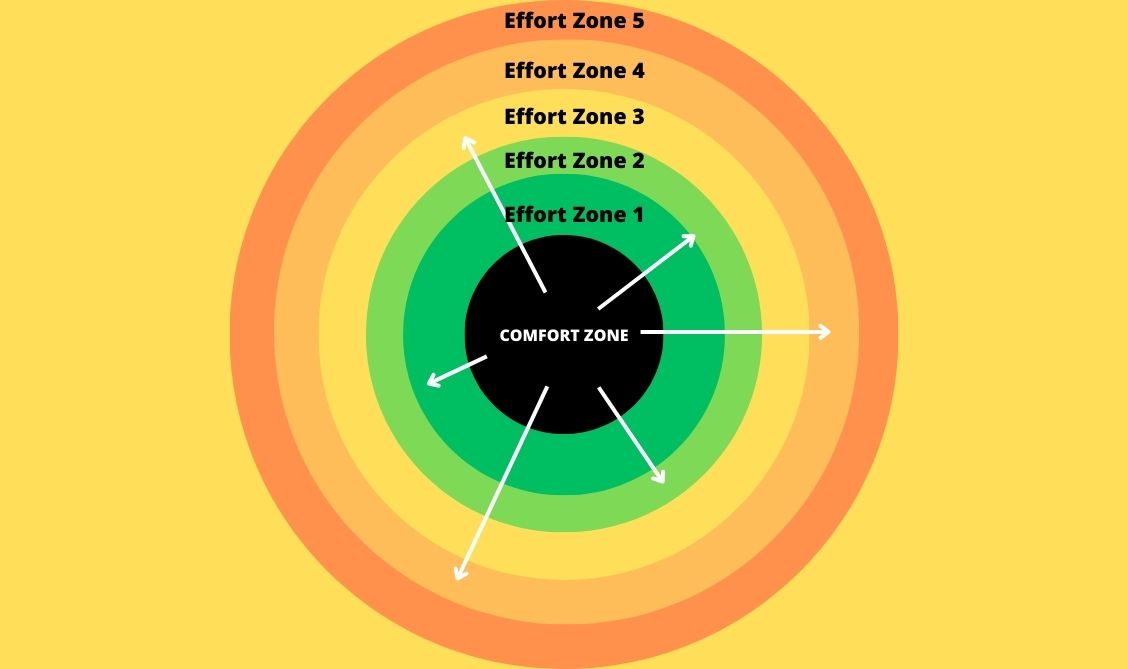We all know that it’s important to get out of our comfort zone. Doing so allows us to grow, learn new skills, and gain valuable experiences. Stepping outside of our comfort zone can lead to personal and professional development, and ultimately, a more fulfilling life. But where do we go once we leave our comfort zone? The answer is that we enter the effort zonees.
The effort zones are where we push ourselves beyond our limits, where we take on challenges that may seem daunting or even impossible. It’s where we apply the lessons we’ve learned in our comfort zone and use them to tackle new and unfamiliar situations. The effort zone is where we truly test our abilities, and where we have the potential to achieve great things.
Entering the effort zones may not be easy, and it often requires hard work, dedication, and perseverance. However, the rewards can be immense. By pushing ourselves beyond our comfort zone and into the effort zone, we can build greater self-confidence, learn new skills, and achieve our goals. We may also discover new passions and interests that we never knew we had. So, if you’re looking to grow and develop as a person, don’t be afraid to step outside of your comfort zone and into the effort zone.
The 5 Effort Zones

Zone 1 : The familiar zone
The first level of effort is the familiar zone. This is the space where you feel most comfortable and at ease. You know what to expect and feel in control of the situation.
👟 In sport, we call it the very light activity or the recovery zone. This is your most comfortable zone. You will become healthier in this zone but not improve your fitness level. If walking is your comfort zone, the familiar zone would be when you are walking on a fast pace.
Zone 2 : The learning zone
You are trying new things and learning new skills. You may feel a bit uncomfortable, but it’s an exciting place to be. It’s comfortably uncomfortable.
👟 In sport, this is the warm up. It is your “slowly start jogging, rowing or pedaling zone”. This zone is preparing your body for increased rate of fat release and the higher intensities to come very soon.
Zone 3 : The growth zone
This is where you are actively pushing yourself outside of your comfort zone to learn and grow. It can be challenging, but also rewarding. The growth zone might look uncomfortable. It’s where most people get stuck.
👟 In sport, it’s the challenging-doable zone. The pace and intensity is challenging but could be continued for 20-30 minutes.
Zone 4 : The panic zone
This is where you feel overwhelmed and stressed, and your fight or flight response kicks in. It’s important to recognize this zone and take a step back if you feel you are not ready yet. However, it is in this zone that you will get the most out of it.
👟 In sport, this is the most important zone. The pace and intensity is uncomfortable and where you “feel the burn”. Spending time in this zone will make you faster and leaner.
Zone 5 : The danger zone
The fifth and final level of comfort zone is the danger zone. This is where you are in extreme discomfort or danger.
👟 In sport, this is the “All out effort!” zone. It’s the highest zone you might achieve when you empty your tank. You do not need to reach this zone to experience maximum result. If you do reach this zone, you will only want to be there for 30 seconds, 1 minute at the time.
How to identify your current zones ?
It’s important to note that these zones can be subjective and vary depending on the individual and the situation. Understanding your own effort zones and where you feel most comfortable can help you identify opportunities for growth and personal development.
When I was training for a half ironman, which consisted in 1,8 km swimming, 90 km cycling and then 21 km running, the first step was to evaluate my current situation (my zones) in each of this discipline. I was good at running, but my swimming technique was really bad.
In sport, there are several techniques to define your zone. Based on the heart rate or on the lactate threshold. But how do we do in life ? We will
First, start by defining the objective. Then, evaluate your current situation. Based on that, create your training plan. And finally, achieve your goal and get the reward.
Define the goals
Later on this blog, I will create an article on how to define SMART goals. Those are Specific, Measurable, Achievable, Relevant and Time-bound.
Your objective might be to complete an ironman in less than 12 hours in 6 months. Or to host a Ted Talk in front of 1000 people in 1 year.
Evaluate your situation
Now that you have your objective in mind, we need to evaluate where you are today. Are you already very comfortable with public speaking but you don’t know the topic yet ? Or is it the opposite, you already know extensively about the topic you want to share but feel uncomfortable with public speaking ?
Create the training plan
Next, we define the training plan. The idea is to enter the effort zones little by little. The training plan has to be very specific : we need to specify when are we going to do what.
Achieve your goals
Finally, achieve your goals and most importantly, take your reward ! Take a moment to reflect on the last 6 months and enjoy the person you became. Growth is not only about effort, it’s becoming a better person. And now you are ! You have acquired a new skill.
Be proud. And repeat to continue to grow, continue to get the best out of life.

Leave a Reply